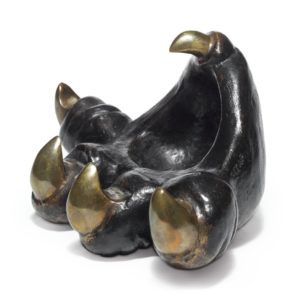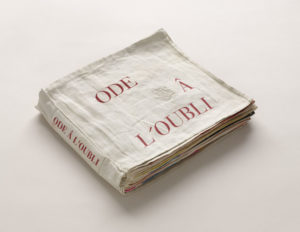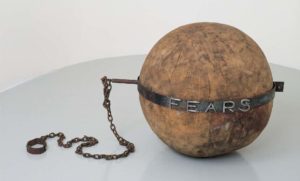Dear Artist,
Yesterday, Jennifer Foster wrote, “I was recently at an arts professionalism seminar where one of the presenters was a gallery owner. I asked him about submitting work to galleries in more than one medium. He surprised me by saying that anyone who did this simply showed that they didn’t know who they were as an artist. I always thought that diversity and ability in many media were strengths — just as cross-training is for an athlete. When submitting to a gallery or a jury, do artists do themselves a disservice by showing work in more than one medium?” Thanks, Jennifer. Artists need to realize that dealers are often coming from a different place than artists.

Give or Take (How Do You Feel This Morning?), 1990
Bronze
4½ by 9 by 6 inches
by Louise Bourgeois (1911-2010)
While you and I know that cross-training and diversity are desirable, even necessary for creative growth, a dealer looks at an artist’s work with other things in mind. Product consistency is one of them. Dealers are, after all, entrepreneurs. In this role, most dealers like to slot each of their artists into specific media and genre. Many of them think they know what their customers want, and don’t wish to muddy the waters. It’s sad to say, but many excellent dealers are not too interested in your range of capabilities. My advice is to submit consistent, one-medium work at first. You can go about showing your breadth and depth later. Here are a few ideas for the multi-media and multi-talented artist:
— Keep working and developing independently, no matter what.
— Deliver work in different media to different galleries.
— Deliver work of different subjects to different galleries.
— “Leak” your multi-media activities by blog or word-of-mouth.
— Give dealers exclusivity in specific geographical locations.
— While it’s good to make consistent and regular deliveries, don’t worry if you miss a stroke or two.
The nature of our game is to be distracted by our muse, and while this may not always be good for the wallet, if the dealer has character, he’ll respect your wanderings. Finding copacetic dealers is a fact of life in visual arts. You need to vacuum out the scissorbills and the not-so-swifts. After the cleanup, you’ll find the rest to be gentle enthusiasts, strong advocates, and good friends.
Best regards,
Robert
PS: “The person who reps you is golden.” (Nick Farbacher)
“Galleries are displaying a product. They’re not museums.” (Nohra Haime)
Esoterica: Juried shows present a refreshing facet to the acceptance game — generally no commercial instincts are in play. As a juror I’ve often noticed an artist’s change in media opens a door to new brilliance. Opportunities sometimes follow. Even switching from oils to pastels may bring out a capability that was stultified in the previous medium. In today’s world of electronic arts, fractals and Watson-inspired machine-art, it’s all so very hard to resist. For an artist, exploration is oxygen.
This letter was originally published as “Problems of the multi-media artist” on March 1, 2011.

Ode à l’oubli (Ode to forgetting), 2002
Fabric illustrated book with 35 compositions: 32 fabric collages, 2 with ink additions, and 3 lithographs (including cover)
11 x 12 3/16 x 1 ¾ inches
by Louise Bourgeois
Have you considered a Premium Artist Listing? With each letter, an artist is featured at the bottom of this page. The Premium Artist Listings are a means of connecting artist subscribers through their work. Proceeds from each listing contribute to the production of The Painter’s Keys.
“Business sure screwed up the art world universally.” (Robert Rauschenberg)
Featured Artist
My aim as a painter is to bring to life a slice of the world as I experience it. Light, color and form are my vocabulary.







11 Comments
This was timely for me. I was a printmaker for 32 years, doing multiple plate etchings. I moved on to monotypes, then acrylic painting in 2011. I have not produced or printed from plates since then but I still have plates and prints I would like to sell. I’m even hesitant to put the etchings on my website for fear of not being consistent or confusing collectors.
I think we can’t confuse marketing with our artistic endeavor. Keep the website for your current work and find other avenues for the etchings. At least that is my approach.
Good idea. Thanks
I’ve thought about the idea of different galleries for my ‘non-established’ market. I wonder though, if given the precariousness of economics right now, how many galleries are wanting to take ‘a chance’ on an artist’s other works. On the other hand, galleries know their markets and buyers so if they think they can sell your work no matter the medium or subject it could be a win-win situation very quick. I agree with Robert’s advice to continue to push into growth no matter what.
When I think of diversified artists I think of Picasso, Warhol, Lalique, Tiffany etc. They didn’t restrict themselves to one medium……why should they? You might accidentally find success in a medium that is least familiar to you. Try everything is my motto.
So agree! My goodness are the galleries leading the culture or is not that the call of the artists!?! Never give up the idea of the “Renaissance Man”! What would the world have done without Michelangelo or Da Vinci !!!
Dealers and galleries know their business and what they want from artists. That’s completely different from pronouncing on an artist’s direction, practice or interests. My own experience – having been an art historian, public and private gallery staffer and art “critic” before having significant first hand experience as an artist – has clearly demonstrated what should be obvious -that, as in any other field, non-practitioners are not qualified to advise or otherwise pronounce on practitioners’ business, however successful they are at their own business. It’s beyond presumptuous, not to mention irresponsible.
I have usually shown a rather diverse group of paintings with my solo shows. People who follow me seem to find a common thread, at least in their mind. One needs galleries that fit your needs. Of course the really big time, blue chip outfits are picky and adhere to the singular direction approach. Easier to handle the marketing, not to mention the historical aspects.
Though this may be a problem in general it hasn’t hurt me significantly in any way, when you consider the excitement of exploration that most artists crave.
Rejection is in itself a form of advice, presumptuous perhaps, but not irresponsible in respect to doing business. Galleries are in business to make money….consider the 40%-50% commission maxim imposed on work….even more in some cases, and that includes many self-appointed on-line on-line art venues. Shows cull work and get paid for the practice with jury fees, $$ for each image over minimum, insurance, postage, return postage plus commissions if the work actually sells….all for a hallowed spot in a short lived exhibit in some artsy urban neighborhood or college campus. If an artist must rely on sales to survive, that fact alone will deter deviance from what is a proven seller.
It never ceases to amaze me how culpable artists are….how eager to be approved of….so much so that the continued market exploitation is expected, endured….taken for granted.
Follow your muse wherever it leads you….you’re an ARTIST for heaven’s sake!
I couldn’t agree with you more, Joan. In the past two years I have delved into any medium I feel allows expressing the essence of a subject and have been wonder-filled at the sales. I also rotate work constantly in my gallery spaces. One painting moved from a classroom to my easel in our studio brought a sale in less than an hour. I live and love to experiment!
It all comes down to personal growth and understanding the whole art game through enough years of learning the why’s and why not. I recall many years ago when putting work before juries in hoping to get accepted to be among the artists on the list of active members, the ones who were allowed to submit to a show, another level of acceptance once through the first one. I recall getting rejected over and over. I felt I had enough artistic talent to fit in with the others, but that jury said no, I was to submit works all of one medium and same style and presented in expensive framing. Back then, I found it odd that the jurors weren’t looking for diversity in the ambitious artist who was trying to prove she had courage in exploring her creativity beyond a limited medium and style. After 5 trys, I finally made it. I gave in to the demands and painted safe. That was how I viewed it then, paint safe in order to be accepted. Looking back, my work was okay and I had a lot to learn, but I wish i’d done things a whole lot differently. I am lucky to presently be represented by a gallery who is open to their artists growing and experimenting. I think they represent the product of the artists in whatever they choose to produce. it seems to me it’s the artists who chooses their path from my experience. Not that I have a vast array of gallery experience, but what I have had has been good and completely encouraging.